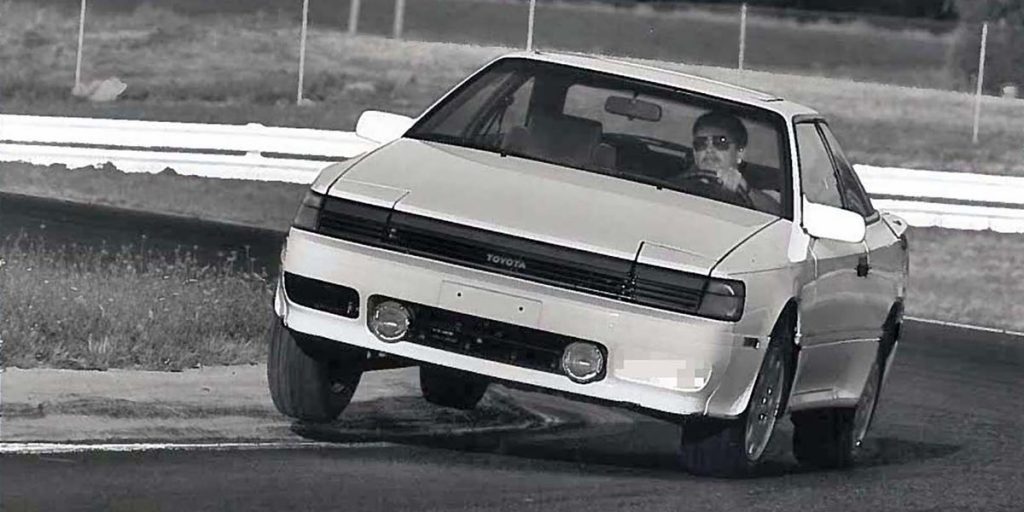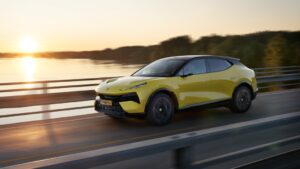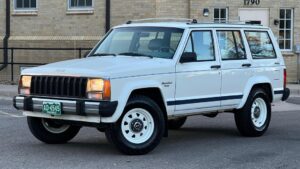Tested: 1988 Toyota Celica All-Trac Turbo Was a Learjet for the Road

From the November 1987 issue of Car and Driver.
A lot of good things come in spray cans these days, but prestige isn’t one of them. Prestige still comes the old-fashioned way, borne on waves of public esteem. Ripples of honorable mention aren’t enough; it takes crashing waves of approbation to loft person, place, or thing into the prestigious upper ranks.
Consider the car business. Everybody knows the prestigious and near-prestigious brands because—well, you just know. That’s how prestige works. Mercedes has got it, and so does Porsche. Cadillac is slipping. Honda is a comer, despite its low-price stigma. And the oddsmakers are now touting Ford as a long shot.
In the ceaseless jostling for a place on the prestige dais, Toyota has yet to find its opening. The company does the hard things of carmaking conspicuously well. Its cars are as reliable as the yen. Their quality is exceptional. Their noise and vibration isolation is excellent. Their controls—particularly the throttle linkages and the shifters—are wonderfully accurate and free of friction. And some Toyota models are certified heroes. When was the last time anything less than bouquets was tossed to Mister Two?
Celica Tested and Compared!
Yet the tidal waves of prestige still keep their distance from Toyota. What’s an ambitious and talented car company to do?
How about building a showcase? A car so far beyond its maker’s earnest reputation that the world finally wakes up and takes notice? A car so seamless in its virtue and heroic in its content that prestige can no longer be denied?
How about a few boatloads of exotic Celica All-Trac Turbos to put some juice into the name “Toyota”?
This is a pretty wonderful car, this hormone-injected Celica. And we say that with the full realization that one man’s wonderful is another man’s “Hmmm, interesting, but …”
The current Celica is a slick rendition of the classic two-plus-two, hatchback-coupe idea. “All-Trac” is Toyota’s American-market term for four-wheel drive. And “Turbo” in this case denotes a sixteen-valve four-cylinder with 1998 cc of displacement, all puffed up and intercooled to 190 hp. The result is a horsepowerful four-wheel-driver of modestly extroverted appearance.
All of this mechanical excitement has been extruded through Toyota’s unique sense of how a special car should behave. The Celica All-Trac Turbo is comfortable, quiet, and refined—the sort of car you could trade in a BMW for without feeling as if you’d taken a step down.
In other words, this is the gentleman’s all-weather interceptor.
So…whaddaya think? Does the introduction of this showcase change your appraisal of Toyota?
Probably the answer comes down to the gentlemanliness of your car taste. If you think along the lines of responsible transit—say, a better Audi Turbo Quattro for fewer bucks—this is the car. Its price has yet to be announced, but we’re guessing about $20,000 for an All-Trac with a full complement of equipment, including leather upholstery, a power skylight, and anti-lock brakes. When the weather is threatening and you need to get to the other side of Nebraska in the least amount of time, the Celica All-Trac Turbo is the next best thing to wings.
Okay, but let’s say your interests run to more (heh-heh) vivid pursuits, like rat racing on Mulholland Drive and pushing your own personal g-sensor into the red zone. The calculator suggests that a 190-hp Celica should be 41 percent more zowie than the 135-hp Celica GT-S, which clicked off a 0-to-60 time of 8.1 seconds in our last test and cleared the quarter-mile in 16.0 seconds at 85 mph. Forty-one percent more than that should grab your full attention and hold it for ransom.
But the Celica All-Trac Turbo aims higher than that. Toyota, after all, is a high-minded car company. Why create a mere sprinter when you’re capable of a decathlon champ?
Remembering back to the start of the project, Toyota engineers say they weren’t after a car that was simply powerful. Nor did they focus solely on four-wheel drive. They wanted a powerful car that could put all of its power to the road, yet would not compromise the refinement that Toyota sees as part of its identity.
All of this was accomplished in due time—at a cost. The All-Trac Turbo you see in the photos crossed the scale at 3295 pounds, up 592 pounds from the front-wheel-drive GT-S. An exact weight comparison is tricky, though, because certain GT-S options are standard in the new car. Toyota says the base All-Trac Turbo weighs 532 pounds more than the base GT-S, and there would be little point in splitting the hairs any finer. You get the idea. A lot of bulking up is required of a decathlon contender.
All of this weight stems from three sources. Horsepower adds weight. The engine block has been strengthened, for example, and the turbocharger and its plumbing and its air-to-water intercooler all add pounds. Horsepower adds weight to the drivetrain as well. A 190-hp clutch weighs more than a 135-hp clutch.
Then there is the four-wheel-drive system. Toyota didn’t cut any corners here. It’s a full-time arrangement, with a center differential. A viscous coupling limits the slip of the front wheels relative to the rears, and the prop shaft through the center of the car consists of three pieces and four U-joints, a design that keeps driveline noise and vibration from disturbing the passengers. Additional isolation has been provided by mounting the rear suspension and differential on a subframe.
The third source of weight has to do with Toyota’s view of how a Toyota showcase should behave. It should be a silken wonder: no buzzes from the four-cylinder, no thrums from an excited underbody. So darn near everything in the car was stiffened up a bit. The engine-mount brackets are stiffer, the mounts themselves have been retuned, the floorpan is all new and stiffer, and the front structure is stiffer. It’s the old story: a few pounds here, a few there, and pretty soon you’re making deep tracks.
Toyota engineers are philosophical about all this extra weight. They say that refinement inevitably adds pounds, and that there was some hard bargaining between the engineering department and the product-planning department about how refined the All-Trac Turbo should be. They think the compromise, as it was finally hammered out, is the lightest it could be at this level of refinement.
The testers on this magazine are less philosophical. Those who place a high value on low mechanical ruckus are impressed. From the feel of the engine, you’d never know it’s a four: there is virtually no vibration to give away the clamorous little secret. The exhaust note—and perhaps the heft and frequency of the power pulses—are the only clues. This is an exotic with charm-school manners. The net effect is rather like a Learjet for the road.
Those of us who place a high value on the zowie factor are impressed, too. The All-Trac Turbo betters the Celica GT-S’s 0-to-60 time by 0.8 second and its quarter-mile performance by 0.4 second and 3 mph. The All-Trac’s top speed is 135, up 13 mph. These aren’t the 41-percent improvements that the calculator predicts, but they’ll do just fine. In the world of gentlemen’s interceptors, this new Toyota is right up there with such luminaries as the BMW 325is.
The All-Trac doesn’t always shine so brightly, however. On the skidpad it turns in only 0.74 g, down from 0.82 in the GT-S. And its stopping distance from 70 mph is 202 feet—the longest we’ve ever recorded for a car equipped with anti-lock brakes. Given the weight increase and the fact that the All-Trac wears the same size rubber as the GT-S, such mediocre grip isn’t too surprising.
So, again, whaddaya think? Does the performance measure up to the mission? We go back to the idea of prestige, and to the related notion of the gentleman’s allweather interceptor. Prestige in the automotive sense frequently comes from performance you can’t use. How many Testarossa speedo needles do you think are still waiting to see that last 50 mph of arc on the dial? How many Corvettes are whipped through the twisties at 0.86 g? How many All-Trac Turbos will be required to get to the other side of Nebraska as quickly as possible in inclement weather? Maybe the point of exotics, whether they’re Ferraris or Toyotas, is that you could…you could really do the deed…if you had to. Otherwise, they are simply heartwarming machines for piercing the dullness of Interstate travel.
The Celica All-Trac Turbo never fails to be heartwarming. Its interior is little changed from the GT-S, but it seems just right, with white-on-black gauges, slick controls, and a rest for the left foot. Thanks to a multiplicity of seal and steering-column adjustments, one size fits all. The seat cushion tilts. A power button on the console deftly summons lumbar support and fine-tunes the upper side bolster for more or less lateral restraint. With the optional leather, the All-Trac is a first-class compartment for the driver.
The All-Trac’s outside appearance is just enough different from the GT-S’s to signal the informed observer without attracting the gawkers. From the bumper line down, the plastic panels take a more streamlined shape. Round fog lights in front and an “All-Trac” decal on the tail are prominent indicators. Few will notice the V rating of the tires.
The satisfaction of this car are mostly wired into the driver’s office. It fits so well. Its controls are so slick. There is so little ruckus from below. Yet when you push on the pedal, there is that extravagant surge that eludes the test-track instruments. Moreover, the All-Trac is like a bullet on the road. It has a very sure sense of straight ahead on the Interstate, yet it’s agile in the twisties as well. We didn’t have a chance to try our pre-introduction sample in nasty weather, but it comported itself smartly in the dry at Portland International Raceway. A good four-wheel-driver should go about its business without calling attention to itself, and the All-Trac does exactly that. Its only racetrack clue to four-wheel drive is its lack of throttle steering. This is one of the few cars around in which the right pedal makes you go faster or slower, and nothing else.
In conceiving this car, Toyota gave itself one of the toughest assignments in automobiling—the refined performance car—and it succeeded admirably. But will its achievement bring prestige? Not unanimously, we think. “Perfect performance” would be widely appreciated by the go group, and “perfect refinement” is the ideal of the cruisers. But refined performance, by definition, will come up short on both components of the blend.
So, if the staffers of this magazine are any indication, the Celica All-Trac Turbo is one of the most controversial cars of this season. Let’s just leave it at this: If you agree with the mission, you’ll delight in the machine.
Specifications
Specifications
1988 Toyota Celica All-Trac Turbo
Vehicle Type: front-engine, four-wheel-drive, 2+2-passenger, 3-door coupe
PRICE
As Tested: $20,000 (est.)
Options: anti-lock brakes, air conditioning, power sunroof, leather seats, sound system with programmed tone control, cruise control
ENGINE
turbocharged and intercooled, DOHC 16-valve 4-inline, aluminum block and heads, port fuel injection
Displacement: 122 in3, 1998 cm3
Power: 190 hp @ 6000 rpm
Torque: 190 lb-ft @ 3200 rpm
TRANSMISSION
5-speed manual
CHASSIS
Brakes, F/R: 10.0-in vented disc/10.6-in disc
Tires: Dunlop SP Sport D87M
F,R: 205/60VR-14
DIMENSIONS
Wheelbase: 99.4 in
Length: 171.9 in
Width: 67.3 in
Height: 49.8 in
Passenger Volume: 79 ft3
Cargo Volume: 16 ft3
Curb Weight: 3295 lb
C/D TEST RESULTS
60 mph: 7.3 sec
100 mph: 6.7 sec
1/4-Mile: 15.6 sec @ 88 mph
Results above omit 1-ft rollout of 0.2 sec.
Rolling Start, 5–60 mph: 3.8 sec
Top Gear, 30–50 mph: 13.4 sec
Top Gear, 50–70 mph: 11.4 sec
Top Speed: 135 mph
Braking, 70–0 mph: 202 ft
Roadholding, 300-ft Skidpad: 0.74 g
EPA FUEL ECONOMY
City/Highway: 20/25 mpg (est.)
C/D TESTING EXPLAINED
This content is imported from OpenWeb. You may be able to find the same content in another format, or you may be able to find more information, at their web site.






